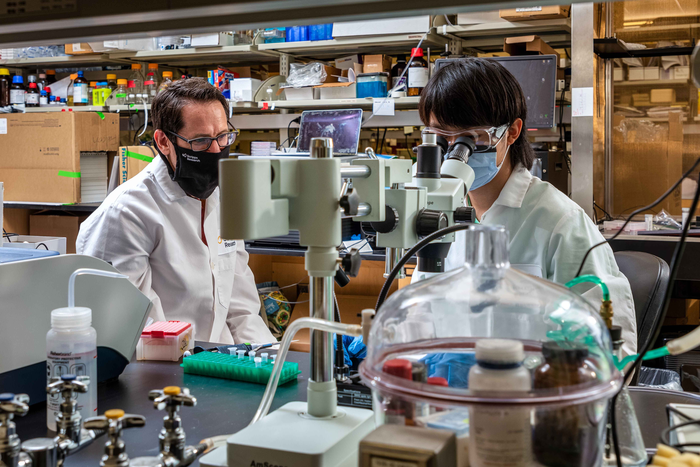A gene mutation in the brain 200,000 years ago may be responsible for human language, as seen in a controlled experiment on the NOVA1 gene.
By Antarjot Kaur
Researchers have discovered how a human-specific gene mutation in the NOVA1 gene alters mice vocalizations, offering clues to the human language evolution.
How language and gene mutation are linked
Why are humans special? Spoken language, among many other characteristics, distinguishes us from all other species. For a long time, scientists have been curious about the genetic foundations of speech-based communication. Although many theories have focused on anatomy and the brain, new genetic research is revealing more detail. Researchers from Rockefeller University published a groundbreaking study in Nature Communications highlighting the NOVA1 gene. This may provide hints about how human communication evolved.
According to the study, a single genetic mutation in the NOVA1 gene, unique to modern humans, may have impacted the development of brain pathways essential for vocal behavior. By genetically modifying mice to introduce this human-specific gene mutation, researchers discovered unexpected information about how this small change impacts vocal communication.
What is NOVA1?
The gene NOVA1 significantly influences brain function, as stated by the study researchers. The protein it produces binds to RNA and affects the expression of genes in the brain. Humans and other mammals share NOVA1, which is highly conserved, meaning that over millions of years, it has stayed almost the same in all species. However, humans differ in a tiny way. Neanderthals, Denisovans, and early humans all had an isoleucine amino acid at a particular location in the protein. Modern humans’ amino acid composition changed to valine at some point during our evolutionary history.
Researchers think that this seemingly insignificant alteration may have had a significant effect on brain activity. Using CRISPR gene-editing technology, they produced “humanized” mice to investigate how this gene mutation affects brain activity and behavior.
Humanized mice: an evolutionary perspective
The genetically altered mice grew normally and displayed no appreciable variations in their general health or physical characteristics. But when the researchers looked at these mice’s brains, they discovered molecular alterations. In particular, the gene mutation changed the way some RNA molecules were spliced by the NOVA1 protein. The way different genes are read and expressed in the brain is determined by this splicing process.
Numerous genes that are impacted are involved in synapse formation and neuron communication, two processes that are fundamental to complex behaviors. Curiously, a number of these genes are associated with vocalization. According to the researchers, this further suggests that the NOVA1 mutation may affect the development and operation of communication-related brain circuits.
RELATED: Music Helps Rebuild Language After Stroke
Vocalization changes in mice
The researchers recorded the gene-altered mice’s vocalizations to investigate the behavioral effects of the gene mutation. Mice make ultrasonic distress calls to indicate that they need attention when they are separated from their mothers. Because these calls prompt the mother to retrieve her pups, they are essential for survival.
When compared to normal mice, the researchers discovered that the gene-altered mice made distress calls that differed slightly but significantly. The calls were changed in volume, pitch, and complexity. For instance, the gene-altered mice made the most common call, a straightforward “flat” sound, more frequently but with less amplitude. There were fewer calls with pitch jumps or more intricate structures, and their acoustic characteristics changed.
These changes were not limited to pups. The songs of adult male mice, who use vocalizations during courtship, also varied. Their calls differed in frequency, pitch, and duration, which may indicate that the gene mutation may have an impact on mice’s social communication. Despite their inability to “talk,” mice’s vocalizations provide a helpful model for researching the fundamental components of communication.
RELATED: AI Unplugged: New Metamaterial Sensor Classifies Spoken Words
The origins of human language in genetics
Why is this important to people? Although human speech and mouse vocal communication may appear to be very different, the underlying brain mechanisms are similar. The study researchers emphasize how neural circuits can be reshaped in ways that affect communication behaviors by even minor genetic changes. These modifications may have contributed to the development of spoken language in humans.
According to the researchers, around 200,000 years ago, during a crucial stage of human evolution, the NOVA1 mutation most likely occurred. The rise of contemporary Homo sapiens as a separate species occurs during this time. The gene mutation might have aided in the development of neural pathways supporting complex vocal learning and speech by altering the way the brain processes RNA. The study offers strong evidence that NOVA1 contributed to the development of our special capacity for communication, even though its precise function in human language is still unknown.
RELATED: Proof of Evolution Is in Your DNA
Wider consequences for neuroscience
Beyond its evolutionary significance, this study provides new insights into the role of genes in behavior and brain function. The results demonstrate how minor genetic alterations can significantly impact behavior and emphasize the role that RNA splicing plays in forming the wiring of the brain. This information may be useful in disciplines like neurology and psychiatry, where new treatments may be informed by knowledge of the genetic foundation of disorders related to communication.
The study also highlights how effective it is to study human characteristics using animal models. Researchers can examine the consequences of genetic alterations in a controlled setting by introducing particular gene mutations into mice. This method provides a means of investigating difficult issues regarding human evolution that would not otherwise be resolved.
Looking ahead
By revealing how a single gene mutation affects brain function and communication in mice, researchers have taken an important step toward understanding the evolutionary roots of human language. As science continues to uncover the genetic basis of our unique traits, one thing is clear: even the smallest changes in our DNA can have a profound impact on who we are.
This study was published in the peer-reviewed journal Nature Communications.
Reference
Tajima, Y., Vargas, C. D. M., Ito, K., … & Darnell, R. B. (2025). A humanized NOVA1 splicing factor alters mouse vocal communications. Nature Communications, 16, 1542. https://doi.org/10.1038/s41467-025-56579-2

About the Author
Antarjot Kaur is a cognitive science undergraduate from India, passionate about healthcare policies, behavioral science, and neuroscience research focused on neurodegenerative memory disorders like Alzheimer’s, dementia, etc., and particularly involved in women’s health issues, education, and empowerment.




